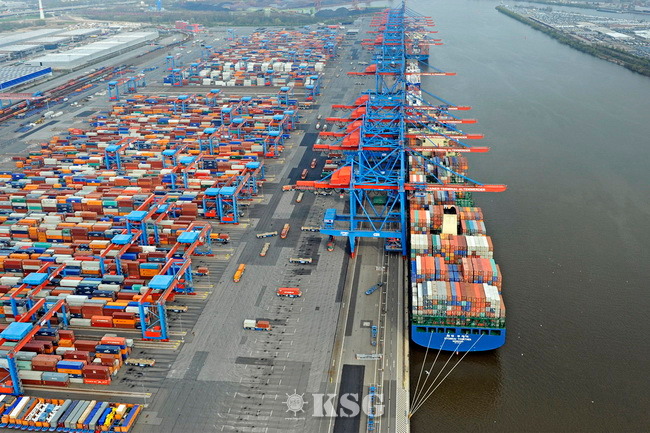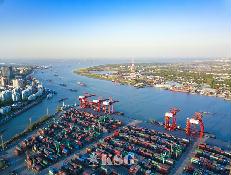2021-11-16 09:32
Cooperation the Key to More Environment-Friendly Shipments

With port and logistics centres included, global freight traffic is responsible for eleven percent of worldwide CO2 emissions. A transformation of existing transport chains and logistics processes is being both debated and demanded internationally. In pursuit of climate neutrality, the EU has set out a target by agreeing the European Green Deal. By 2050, Europe should become the first climate-neutral continent. Lübecker Hafen-Gesellschaft - LHG and Port of Hamburg Marketing - HHM recently invited experts to discuss what measures will be required in the port and transport sector to achieve this target. At a digital event entitled ‘Climate-neutral into the future – What can we do?’, 375 delegates heard lectures and Q&A sessions.
LHG’s CEO Sebastian Jürgens, joined Marina Basso Michael, responsible at HHM for market development in the Baltic region and Europe, in moderating the expert dialogue between the experts and participants linked up from Germany and other countries. “With our event, we want to produce suggestions for the discussion on climate-friendly transport chains and ports. The exchange between the port/transport industry and the academic world produces fresh approaches and motivates people to expand already successfully commenced cooperation at all levels. At the interface between seaborne and land transport, LHG plays an essential part there,” stated Jürgens.
Carlos Jahn of the Fraunhofer Center for Maritime Logistics and Services raised the considerable potential for more sustainability in the port of the future. In his view, synchronization of seaborne and land transport through digital networking of logistics partners needs to be promoted. Jahn feels that deployment of artificial intelligence and use of larger data quantities should enable waiting times to be reduced and preliminary port storage areas more efficiently used. Realtime data on the vessel and its deployment planning should produce substantial added value for optimizing vessel routes and schedules. In the last resort, reduction of fuel consumption, shorter waiting times, smaller space requirement and adjusted equipment also contribute towards more sustainable organization of ports’ hinterland traffic.
Erik Lewenhaupt presented the Stena Line view on further developments in marine propulsion and the use of sustainable fuels in shipping: “Fuels such as hydrogen, ‘green methanol’ plus growing electrification are examples of how we could move in the direction of greener logistics. Electrification is currently preferred for short distances, ‘green methanol’ for the long haul. To promote its use, we shall require not only substantial investments in existing ships, but also supply infrastructure in the ports. Fleet renewals, engine modifications and enhanced efficiency are essential instruments for ensuring structural improvements in the logistics chain and reducing the CO2 footprint. We at Stena Line aim to be pioneers and are promoting sustained transport logistics,” said Lewenhaupt.
Jan Weiser of Kombiverkehr explained how pre- and post-voyage intermodal transport chains can become more environment-friendly. He forcefully demonstrated how combined transport in an intermodal network can achieve an 80 percent saving of CO2 by comparison with road transport. Use of ‘green’ power and precise recording of rail freight traffic emissions can assist here. Thanks to such existing instruments as the CO calculator, customers are already receiving all the basic details for evaluating climate-friendly shipments. On the way to more sustainability in freight traffic, Weiser also called for improved standardisation and suitability of cranes for semi-trailers. In addition, it is essential to convince forwarders about intermodal transport. “Forwarders need to re-think towards rail,” he said.
< Korea Shipping Gazette >
많이 본 기사
- HMM, 7년만에 대서양항로 재진출…印-북유럽도 신설美서안 2주새 27% 급등…컨운임지수 4주 연속↑안광헌 HD한국조선해양 사장, “조선공학과 해상법은 한몸”페스코, 우리나라·중국-극동러시아 컨항로 새단장대만 양밍해운, 내달 中-태국 신항로 개설“온도관리기능 개선” EAS플랫폼, 유럽형 모듈 냉동탑차 출시광양항, 내년부터 ‘MSC·제미니’ 신규취항…유럽·미주·중동 항로...울산항만공사, 내년 예산 2156억 확정…전년比 3%↑인천내항 1·8부두 재개발사업 본격화…실시협약 체결왈레니우스윌헬름센, 3분기 영업익 4800억…2%↓
- KSS해운, 日 미쓰이와 130억 규모 암모니아운송 계약목포해양大, 예선조합과 항만안전 강화 제휴韓-베트남 AEO 상호인정약정…우리기업 신속통관 기대삼성중공업, 아시아서 7400억 규모 에탄운반선 3척 수주싱 EPS, 신조 중형 정유운반선에 공기흡입식 돛 설치“100억 감면효과” 연안여객선 세제혜택 제도 도입KSS해운, 사랑의 행복나눔 기부금·후원품 전달HJ중공업, 해군서 2663억 규모 신형고속정 4척 수주한국근해수송협의회 김근홍 국장 부친상부산항만공사, 내년 예산 22% 늘린 1조7338억 투입
스케줄 많이 검색한 항구

































































0/250
확인